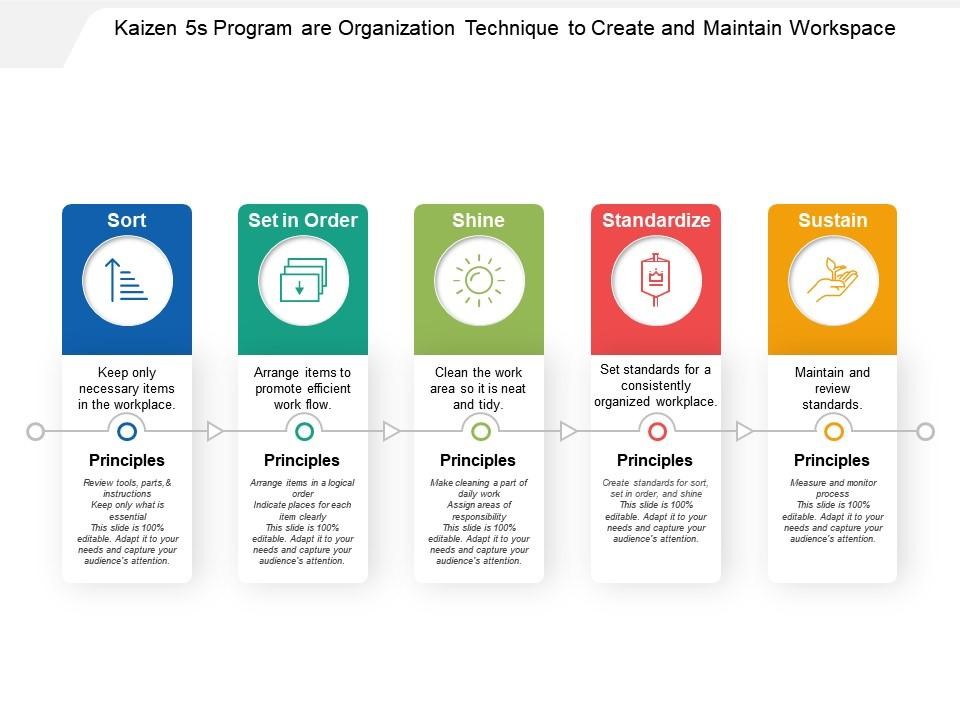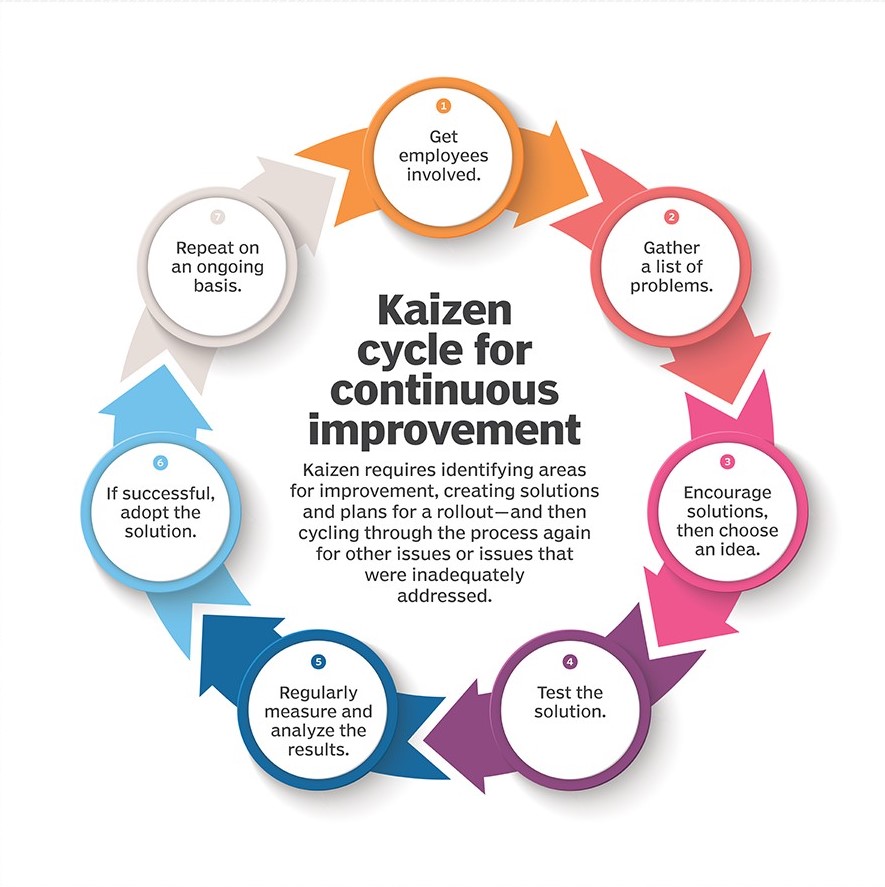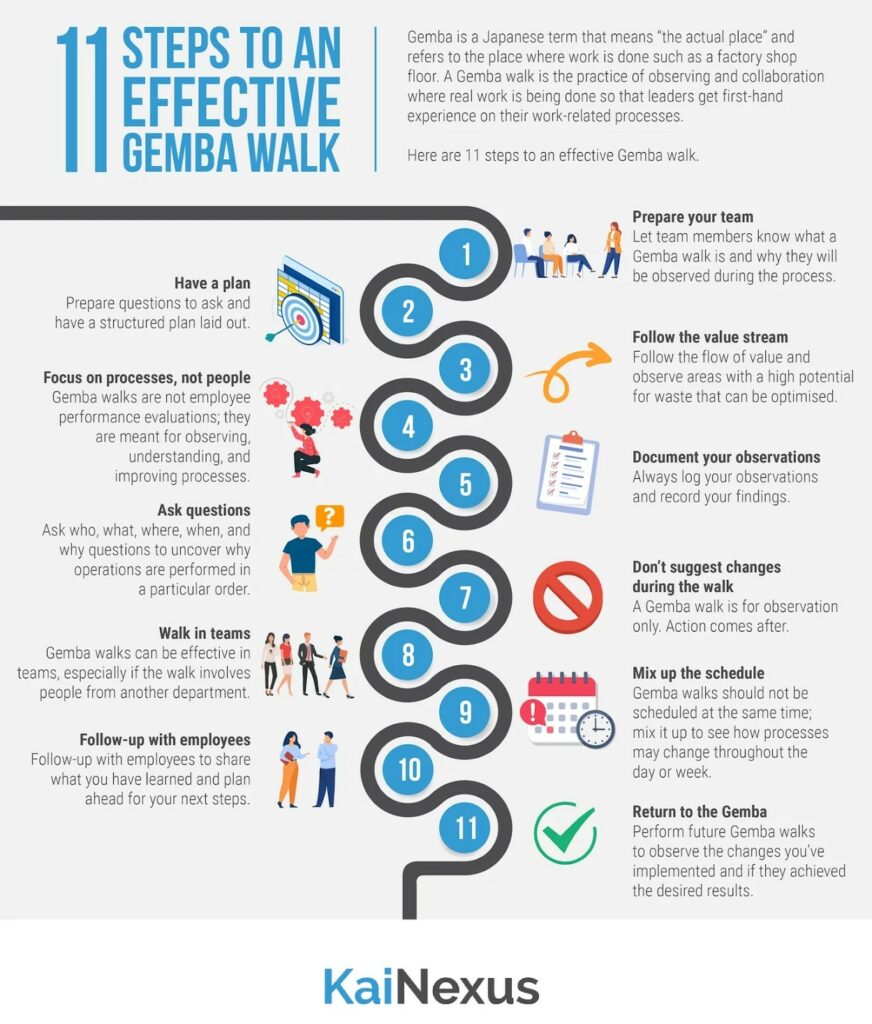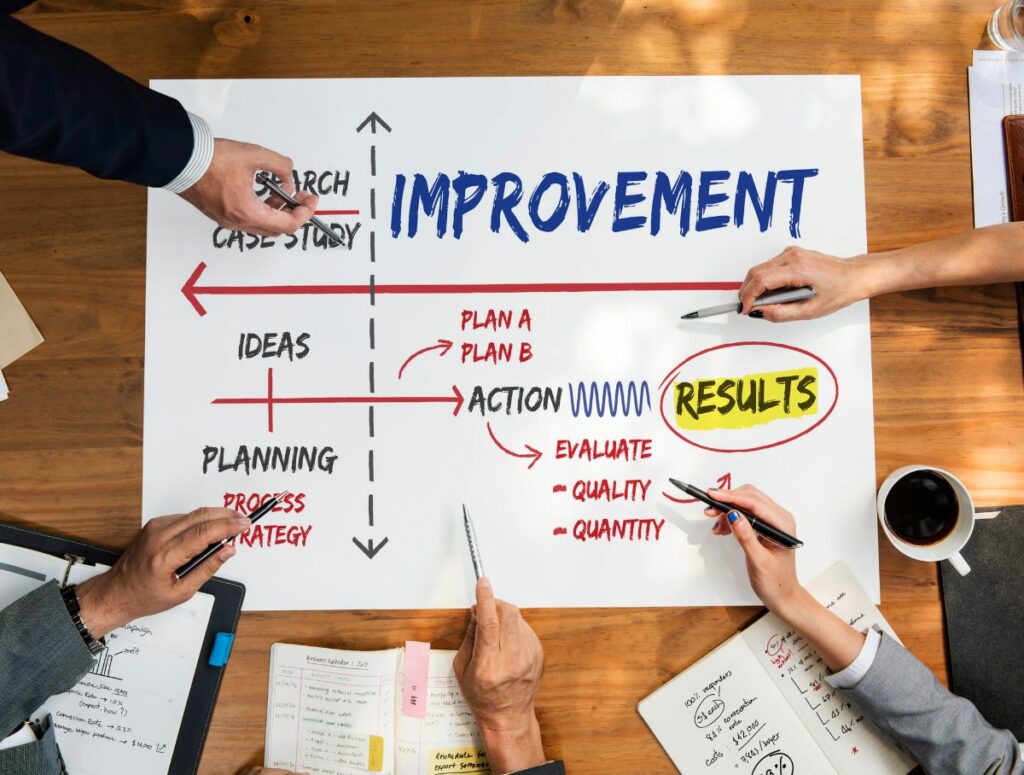Table of Contents
ToggleKaizen is a Japanese term that is divided into two parts- Kai and Jen, meaning change and for better, respectively. The Kaizen method is a rapid improvement process and is often considered the “building block” of all lean production methods. Kaizen methodology focuses mainly on eliminating waste, improving productivity, and achieving sustained continual improvement for all activities that align with the organization’s goals.
History of Kaizen
Kaizen originated in Japan after World War II when the country was undergoing
economic reform and needed to rebuild its industries and economy. One of the most influential figures in the development of Kaizen was W. Edwards Deming, an American statistician who introduced the Plan-Do-Study-Act cycle, a method for testing and implementing organizational changes.
Kaizen was adopted by many Japanese companies, especially Toyota, which used it to achieve remarkable growth and innovation. This methodology became synonymous with Toyota’s production system, which emphasized eliminating waste, improving quality, and empowering workers. Kaizen methodology became a core concept of lean and agile business practices. It is based on the principles of continuous improvement, customer focus, teamwork, and employee engagement.
Core Principles of the Kaizen Method
Adopting the Kaizen methodology entails embracing a set of fundamental principles that drive continuous improvement and efficiency within an organization. These core principles form the bedrock of Kaizen’s philosophy and are essential for its successful implementation. Here are the 10 core principles of Kaizen:
Watch this video to get a proper idea of the core principles of Kaizen
- Customer Focus: Prioritize customer needs and satisfaction, aligning all improvement efforts with delivering value to the end-user.
- Process Orientation: Emphasize a process-centric approach, analyzing and optimizing workflows for enhanced efficiency and reduced waste.
- Employee Involvement: Encourage active participation and engagement of all employees in the improvement process, tapping into their collective knowledge and experience.
- Continuous Improvement: Cultivate a culture of perpetual enhancement, where incremental changes are consistently made to refine processes and achieve better results.
- Elimination of Waste: Identify and eliminate all forms of waste, be it in the form of time, resources, or materials, to streamline operations and improve resource utilization.
- Standardization: Establish and adhere to standardized procedures to ensure consistency, reduce variability, and create a stable foundation for improvement.
- Visual Management: Utilize visual cues and indicators to enhance communication, making it easier to understand processes, identify issues, and track performance.
- Just-in-Time Production: Minimize inventory and reduce lead times by producing goods or services exactly when needed, optimizing production efficiency and responsiveness.
- Quality at the Source: Embed quality control measures directly into the production process, empowering employees to identify and address defects immediately, preventing downstream issues.
- Kaizen Events: Conduct focused, time-bound improvement events or projects to address specific issues, fostering a sense of urgency and facilitating rapid enhancements.
What is the Kaizen 5S Process?
A 5S framework is vital in Kaizen for an organized workplace. The 5S aims to create visual order, cleanliness, and standardization, enhancing efficiency and safety. Here are the original Japanese 5S’s and their English translations:

Image source: https://www.slideteam.net/kaizen-5s-program-are-organization-technique-to-create-and-maintain-workspace.html
- Seiri/Sort (Organize): Separate necessary items and remove unnecessary ones for a tidy workspace.
- Seiton/Set in order (Create Orderliness): Arrange items for easy access in a logical way for work.
- Seiso/Shine (Cleanliness): Maintain a clean and tidy workspace for a better working environment.
- Seiketsu/Standardize (Standardized Cleaning): Establish standard practices for workplace cleanup to ensure consistency.
- Shitsuke/Sustain (Discipline): Maintain the effort consistently to sustain a well-organized workplace.
Kaizen Methodology for Continuous Improvement
This is a seven-step cycle, and the Kaizen process helps to create an environment based on continuous improvement. The following are the steps:

Image source: techtarget.com
- Employee Involvement: Engage employees in identifying issues and fostering buy-in for change.
- Problem Identification: Gather feedback from all employees to compile a list of issues.
- Solution Generation: Encourage creative solutions and select winning ideas for implementation.
- Solution Testing: Implement chosen solutions involving everyone in pilot programs or tests.
- Results Analysis: Regularly assess progress, designate contacts, and keep workers engaged.
- Adoption of Successful Solutions: If results are positive, adopt the successful solution organization-wide.
- Ongoing Cycle: Repeat the seven steps continuously, testing new solutions as needed.
Kaizen Examples
Kaizen can be applied to various fields and industries, such as manufacturing, healthcare, hospitality, and construction. Here are some examples of how Kaizen is used in different sectors:
1. Manufacturing: Toyota is one of the most famous companies that use Kaizen to improve quality, efficiency, and customer satisfaction. Toyota uses tools such as 5S, JIT, Kanban, and the five whys to eliminate waste, optimize inventory, and solve problems at their root cause.
2. Healthcare: Hospitals and clinics can use Kaizen to improve patient care, safety, and satisfaction. For example, a hospital unit can use Kaizen to reduce medication errors, streamline workflows, and increase staff morale.
3. Hospitality: Hotels and restaurants can use Kaizen to enhance customer service, cleanliness, and profitability. For example, a hotel can use Kaizen to redesign its menu, reduce food waste, and increase customer loyalty.
4. Construction: Contractors and builders can use Kaizen to improve project management, safety, and quality. For example, a construction company can use Kaizen to make the job easier for workers, reduce accidents, and deliver projects on time and within budget.
What are the Advantages of the Kaizen Method?
1. Deserving Targets

The application of Kaizen as an improvement methodology extends beyond benefiting the business; it also holds advantages for employees, customers, and the overall organization. This management philosophy is universally applicable across various business types, acknowledging and appreciating the contributions of employees, thereby instilling a sense of value within the organization.
2. Enhanced Collaboration

Kaizen significantly enhances teamwork by promoting collaboration and inclusivity. This quality improvement tool benefits everyone involved in the business process, fostering bonds and team spirit through collective problem-solving. The collaborative approach encourages employees to approach their work with a fresh perspective, impartial minds, and without bias.
Additionally, teamwork in Kaizen extends to cross-functional collaborations, involving skilled individuals from different departments. This not only refines their skills but also taps into opportunities for improvement where different processes intersect. These collaborations create a learning environment, allowing employees with diverse experiences to collectively address challenges. Therefore, Kaizen notably improves teamwork and cooperation among employees.
3. Nurturing Leadership Skills

An additional benefit of Kaizen is the development of leadership skills. Each Kaizen team requires a leader responsible for organizing and coordinating the implementation process. The team leader ensures the successful execution of roles and seeks additional resources when needed. Importantly, a team leader need not hold a managerial position, providing an opportunity for employees to assume leadership roles through Kaizen.
4. Enhanced Operational Efficiency

A significant advantage of Kaizen is the improvement of operational efficiency. Kaizen initiatives elevate service quality, introduce new process improvements, enhance efficiency, and improve time management. For instance, Toyota Manufacturing Company employs Kaizen in its production processes, using muscle-memory training to achieve precise results in car assembly. When efficiency peaks, Toyota strategically reduces the workforce in a plant, minimizing errors and maximizing productivity.
5. Refined Standard Work Document

Implementing changes during Kaizen results in an updated and improved Standard Work Document. This foundational tool guides business practices, serving as a benchmark for Kaizen improvements. The Standard Work Document not only captures current best practices but also becomes the basis for future enhancements. Additionally, it aids in measuring employee performance and educating new personnel about ongoing improvements.
6. Elevated Employee Satisfaction

Kaizen positively impacts employee satisfaction by involving them in the decision-making process for improvements. Through suggestion systems and team meetings, employees contribute creative ideas and suggestions. Inclusion in decision-making fosters a sense of belonging and self-worth, motivating employees to implement changes and devise novel ways to enhance processes. As a result, employees become advocates for quality improvements.
7. Enhanced Workplace Safety

A safety-related advantage of the Kaizen method is the improvement of workplace safety. Implementing ideas that organize and tidy workspaces gives employees better control over business process equipment while encouraging suggestions for safety improvements. This proactive approach minimizes accidents and related injuries, enhancing efficiency and time management. However, it is crucial to note that safety is a shared responsibility involving both employees and management.
8. Waste Minimization

Kaizen excels in reducing waste in business processes, presenting a substantial advantage. As a collective responsibility, both management and staff identify areas of waste in the business process. Through continuous improvements, the root causes of wastage are identified and addressed, leading to the eradication of waste, cost reduction, judicious resource utilization, and improved overall profitability.
What is Gemba Kaizen?
A Gemba walk is a direct workplace observation to boost productivity by engaging with employees and understanding their tasks. Derived from the Japanese term “gemba” or “gembutsu” meaning “the real place,” it emphasizes observing work where it happens. This lean method, used by employers, promotes continuous improvement.
Gemba kaizen, a Japanese strategy, enhances organizational processes and reduces waste through workplace observations and improvements. Guided by principles like customer focus and employee engagement, it taps into the collective skills of the entire organization. Recognizing the value of small improvements over time, Gemba Kaizen encourages and rewards employee contributions for continuous improvement on the ground.
For a Gemba Walk, where you observe and improve work processes, here are some simple steps:

Image Source: blog.kainexus.com
Conclusion
In conclusion, the Kaizen model stands as a powerful philosophy for continuous improvement within organizations. By emphasizing a culture of small, incremental changes and involving every level of the workforce, Kaizen promotes efficiency, teamwork, and a relentless pursuit of excellence. The model’s impact extends beyond process enhancement, fostering employee engagement, leadership development, and a commitment to quality.
As organizations embrace the Kaizen method, they not only realize immediate improvements but also cultivate a mindset that positions them for sustained success in an ever-evolving business landscape. Ultimately, the Kaizen model serves as a guiding force for organizations seeking to thrive through ongoing adaptation and improvement.
Read New Blog on Kaizen – Kaizen Costing – Types, Objectives, Process
